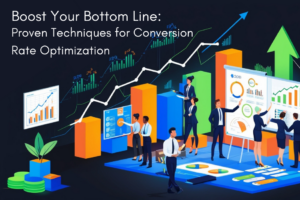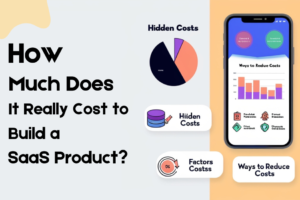Prototype Vs. MVP: Which Approach Is Right For Your Software Development?
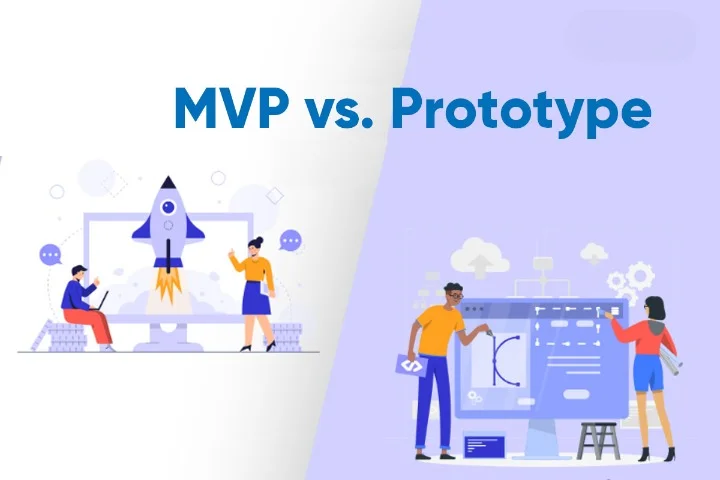
Table of ContentsToggle Table of ContentToggle
Prototype vs MVP Understanding Prototypes: From Concept to Visualization
Prototype vs MVP : Prototypes assume an essential part in the product development process, filling in as the scaffold between unique ideas and unmistakable plans. They are visual portrayals that give an unmistakable and basic look at what the last software development services item will closely resemble.
The basic role of a prototypes vs MVP is to convey and refine thoughts. At the point when a product idea is in its earliest stages, it frequently exists just as a dubious thought. Making a prototypes vs MVP changes this theoretical thought into something concrete. It’s an urgent move toward the planning stage since it helps the enterprise software development services, including Developers, designers, and clients, comprehend the vision and the client experience.
prototypes vs MVP come in different structures, from low-loyalty paper representations to high-constancy intuitive Prototypes. The decision of Prototype sort relies upon the undertaker’s intricacy and targets. Low-constancy Prototypes, as portrayals or wireframes, are straightforward and financially savvy, ideal for early conceptualizing and idea approval. High-constancy prototypes vs MVP, then again, offer a more sensible client experience, impersonating the eventual outcome’s look and connections more meticulously.
The most common way of making a Prototype includes configuration tools and software development services, which consider the representation of the UI and UX. This step is basic in guaranteeing that the plan lines up with the project’s objectives and client assumptions.
Overall, prototypes vs MVP are an imperative tool for carrying lucidity and accuracy to the product development process. They help in envisioning the idea, refining the plan, and lessening mistaken assumptions among partners. Prototype Vs. MVP empower early criticism assortment, savvy changes, and time reserve funds, making them a fundamental piece of the development of custom software development for startups.
Introduction To Prototype vs MVP In Software Development
Prototype vs MVP : Explanation of Digital Prototypes:
Prototypes and Minimum Viable Products (MVPs) serve various jobs in the product development process. While Prototypes are fundamentally centered around representation and planning,Prototype vs MVP are tied in with making useful software. Digitized Prototypes are early portrayals of the UI (UI) and client experience (UX) of a product item. They assist partners and planners with acquiring a visual comprehension of how the eventual outcome will look and feel.
Prototype Vs. MVP are static or intuitive Prototypes that show the format, plan, and stream of the application. They are a fundamental apparatus for beginning phase plans and effectively explain prerequisites, accumulate input, and diminish false impressions. Prototypes are minimal expense and fast to make, making them ideal for refining the visual parts of a product project.
Then again, prototypes vs MVP are completely practical software with restricted highlights. They effectively test the center usefulness of an item in a certifiable climate. prototypes vs MVP are not only for perception; they are real working applications, though with a negligible arrangement of highlights. The essential objective of an MVP is to approve the item’s reasonableness on the lookout, gather client criticism, and pursue information-driven choices for additional turn of events.
Digitized prototypes vs MVP center around envisioning the plan and format of a product development item, supporting the beginning phases of the plan, and correspondence with partners. Prototype vs MVP, conversely, are practical software items intended to test the center highlights and gather client criticism for market approval. While both are fundamental in the product development process, their goals and jobs vary essentially. Prototypes address plan and perception, while MVPs tackle usefulness and market availability.
Prototypes vs MVP : How do Prototypes Work?
Prototypes are a basic part of the product development process, filling in as visual portrayals of an item’s plan and UI. They assume a pivotal part in aiding partners, including originators, designers, and clients, to comprehend how a product development application will look and work. This is the way Prototypes work:
1. Visualization:
Prototypes are principally centered around imagining the UI and UX of a product item. They give an unmistakable and basic portrayal of how the last application will show up on the screen, including components like buttons, menus, structures, and content design.
2. Idea Validation:
Prototypes assist with approving the reasonable plan of the application. By making a visual Prototype from the get-go in the development cycle, groups can guarantee that the plan lines up with the undertaking’s targets and client assumptions. This lessens the gamble of mistaken assumptions and expensive plan changes later on.
3. Intelligent Elements:
Contingent upon the kind of Prototype, it can incorporate intuitive components that permit partners to explore the application as though it were a genuine, working item. These associations might incorporate clicking buttons, finishing up structures, and moving between various screens or pages.
4. Input Collection:
Prototypes act as an important tool for gathering criticism from different partners, including clients, end-clients, and development groups. Clients can give input on the plan, convenience, and generally speaking, client experience, which is fundamental for making enhancements.
5. Iterative Design:
Given the criticism, Prototypes can be updated and refined on numerous occasions. This iterative cycle helps in improving the plan and usefulness of the product, guaranteeing it meets the ideal objectives and lines up with client inclinations.
6. Decreased development Risks:
By making a Prototype, development groups can distinguish potential plan blemishes, usefulness issues, or client experience issues from the get-go in the undertaking. This early discovery can prompt expense reserve funds, as it is normally more affordable to make changes during the Prototype stage than during full-scale development.
7. Specialized Tool:
Prototypes likewise act as a specialized tool, permitting fashioners, Developers, and clients to be in total agreement. They give a common visual reference that aids in explaining plan choices and venture necessities.
8. Kinds of Prototypes:
There are different sorts of Prototypes, going from low-loyalty wireframes and Prototypes to high-constancy intuitive Prototypes. The decision of Prototype kind relies upon the venture’s intricacy, targets, and the degree of detail required.
Generally speaking, Prototypes are a basic move toward the product development process, guaranteeing that the plan and usefulness of an application meet the expected objectives and client assumptions. They help in decreasing vulnerabilities and limiting dangers related to misconception or miscommunication during the beginning phases of an undertaking.
Types of Prototypes : Prototypes vs MVP
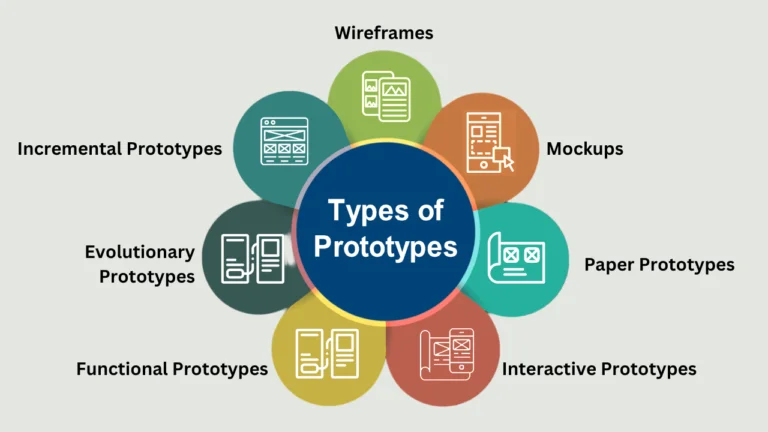
1. Paper Prototypes:
Paper Prototypes are basic and low-tech portrayals of a connection point or item. They are many times hand-drawn representations of screens, UIs, or item plans. Paper Prototypes are savvy and simple to make, making them valuable for the beginning phase of conceptualizing and idea approval. They are ordinarily utilized for social occasions starting input and are not intelligent.
2. Wireframes:
Wireframes are more organized and refined than paper Prototypes. They are normally made utilizing plan software or concentrated wireframing apparatuses. Wireframes center around format and design, showing the arrangement of components, routeways, and content order. While wireframes are not intuitive, they give a more clear visual portrayal of the UI.
3. Mockups:
Prototypes are static, high-devotion portrayals of an item’s plan. They offer a point-by-point visual portrayal of the UI, including varieties, typography, and visual components. Prototypes are made utilizing configuration devices like Adobe Photoshop or Sketch. They assist stakeholders with better figuring out the look and feel of the result however don’t have intelligent usefulness.
4. Interactive Prototypes:
Intelligent Prototypes give a more practical client experience. They are made utilizing particular prototyping devices or software development services and permit clients to connect with the point of interaction. Intelligent Prototypes can reproduce client connections, for example, button snaps, changes, and movements, giving a more vivid encounter. They are significant for client testing and exhibiting the stream and usefulness of an application.
5. Functional Prototypes:
Utilitarian Prototypes go above and beyond and incorporate fundamental usefulness or working highlights of the product. While they might not have the full arrangement of highlights found in the eventual outcome, they permit clients to perform errands and communicate with the application as though it were a functioning framework. Practical Prototypes are valuable for testing and approval and can act as an establishment for development.
6. Throwaway Prototypes:
Expendable Prototypes are many times utilized in the beginning phases of a venture to investigate different plan thoughts and ideas. They are commonly disposed of once their motivation, for example, thought approval or partner criticism, has been satisfied. These Prototypes are not planned for the additional turn of events but rather help in molding the eventual outcome.
7. Evolutionary Prototypes:
Developmental Prototypes are created with the expectation of advancing them to the eventual outcome. They start with a fundamental form of the product and progressively add elements and functionalities because of client criticism and necessities. This approach takes into account constant refinement and development given true utilization.
8. Incremental Prototypes:
Gradual Prototypes include building and refining a product item in more modest, steady stages. Each stage adds new elements or upgrades to the current Prototype. This iterative methodology is valuable for complex undertakings, it is completely tried and approved before pushing ahead to guarantee that each stage.
The decision of Prototype sort relies upon the undertaking’s objectives, the transformative phase, accessible assets, and the degree of detail and intelligence expected for viable correspondence and testing. Various sorts of Prototypes can be utilized at different phases of a venture to help the plan, development, and approval processes.
Prototypes come in various forms, such as paper prototypes, wireframes, mock-ups, and interactive prototypes. Paper prototypes are low-tech and cost-effective, while interactive prototypes offer a more realistic user experience. The choice of prototype type depends on the project’s complexity and objectives.
Reasons To Use Prototypes:

There are a few convincing motivations to involve Prototypes in the product development process:
1. Visualization:
Prototypes give an unmistakable visual portrayal of the product’s UI (UI) and client experience (UX). This helps partners, including clients, originators, and designers, to comprehend the item’s look and feel from the get-go in the development cycle.
2. Early Feedback:
Prototypes take into consideration early input and approval of plan ideas. This input circle can forestall false impressions, lessen revision, and guarantee that the result lines up with the partners’ assumptions.
3. Cost-Efficiency:
Making changes to a Prototype is significantly less exorbitant and tedious than changing a completely evolved software item. By distinguishing and tending to configuration issues early, you save assets and stay away from exorbitant modifications down the line.
4. Diminished Risk:
Prototypes assist with recognizing potential plan defects, ease of use issues, or usefulness holes before focusing on a full turn of events. This chance relief is pivotal for guaranteeing that the eventual outcome addresses client issues and assumptions.
5. Further developed Communication:
Prototypes act as a typical visual reference point for conversations among project partners. They work with better correspondence and arrangement between creators, Developers, and clients.
6. Client Driven Design:
Prototypes accentuate the client experience. By including clients or expected clients in the assessment of Prototypes, you can guarantee that the product is easy to use and addresses their issues.
7. Iterative Development:
Prototyping takes into consideration an iterative way to deal with development. You can make various adaptations of the Prototype, bit by bit refining the plan and usefulness because of client criticism and advancing undertaking necessities.
8. Quicker Choice Making:
Prototypes facilitate direction by giving an unmistakable reference point. This rates up the endorsement interaction, decreasing venture delays.
9. Explanation of Requirements:
Prototypes help explain and refine project necessities. They frequently uncover recently ignored parts of the product that should be tended to.
10. Plan Alignment:
For plan escalated projects, Prototypes guarantee that the visual components, like design, varieties, and typography, line up with the expected plan style.
11. Client Engagement:
Clients or partners might not have a specialized foundation, and Prototypes offer them a substantial means to draw in with and grasp the undertaking’s development.
In rundown, involving Prototypes in software development services offers various advantages, from upgrading representation and early criticism to lessening expenses and dangers. They are a useful asset for guaranteeing that the result addresses client issues, lines up with partner assumptions, and encourages proficient cooperation among the venture group.
Prototype vs MVP : What’s a Minimum Viable Product (MVP)
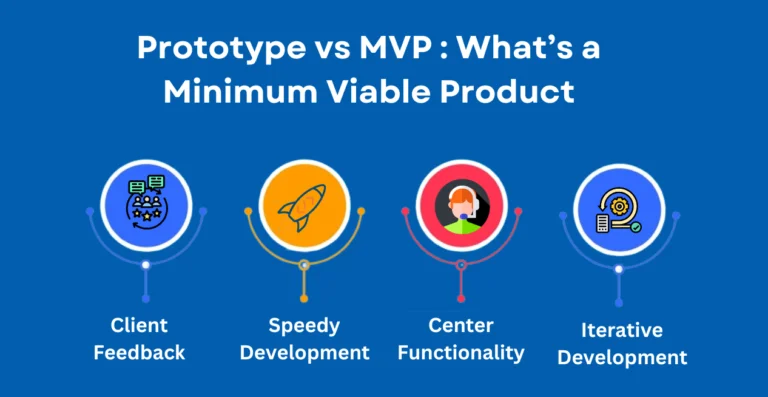
A Minimum Viable Product (MVP) is a utilitarian rendition of a product item that incorporates the center highlights important to fulfill early clients and assemble criticism. Dissimilar to Prototype vs MVP are not only for perception; they are real working applications, though with restricted usefulness. The vital attributes of an MVP include the following:
1. Center Functionality:
An MVP incorporates just the fundamental highlights that address the principal issue or need for which the product is being created. It overlooks trivial elements to smooth out development.
2. Speedy Development:
MVPs are intended to be grown quickly. The emphasis is on getting the item to advertise as quickly as time permits, permitting the development group to answer client input and changing economic situations.
3. Client Feedback:
One of the basic roles of an MVP is to gather client criticism and bits of knowledge. By delivering a utilitarian item, Developers can check how clients cooperate with it, what they like, and what needs development.
4. Iterative Development:
An MVP is the beginning stage, not the eventual outcome. Normally, the Prototype Vs. MVP will develop given client reactions and market criticism. Developers can repeat the MVP, adding new elements and upgrades over the long run.
The MVP approach is an essential one that spotlights on approving an item thought or idea by placing it under the control of genuine clients and gaining from their encounters. It’s an important tool for new companies and organizations hoping to test the market, oversee development costs, and guarantee that their item meets the genuine necessities and inclinations of their ideal interest group.
Essential characteristics of an Prototype vs MVP
Fundamental qualities of a Minimum Viable Product prototypes vs MVP in software development include:
1. Center Operations:
An MVP centers around conveying the center elements and capabilities that address the essential issue or need your item means to settle. It maintains a strategic distance from highlight bulge by including just what is fundamental.
2. Minimalism:
MVPs are purposefully moderate in plan and elements. They take out superfluous intricacies and functionalities to keep the item straightforward and simple to utilize.
3. Speedy Growth:
An MVP is grown quickly, underscoring the rate of the showcase. It’s anything but a thorough, last rendition of the item however a utilitarian variant that can be sent and tried rapidly.
4. User-Centric:
MVPs are worked with areas of strength for the client. They plan to offer quick benefits and accumulate client input to drive further turn of events. Client input is necessary to refine the item.
5. Gather Client Feedback:
The basic role of an prototypes vs MVP is to gather client criticism and bits of knowledge. This criticism guides resulting development, guaranteeing that the item develops in a way that lines up with client inclinations and necessities.
6. Repetitive development:
MVPs are essential for an iterative development process. They are not the result but rather a venturing stone toward making an additional element rich and powerful application. Constant development depends on client reactions and information.
7. Quantifiable Outcomes:
MVPs ought to have quantifiable achievement rules. This could be as KPIs that assist you with evaluating whether the item is meeting its targets.
8. Cost-Efficiency:
MVPs are savvy since they center around the fundamentals, diminishing development costs. This is especially significant for new companies and organizations with restricted financial plans.
9. Risk Reduction:
By testing the item in the market with an prototypes vs MVP, you can distinguish possible dangers and difficulties from the get-go in the development cycle. This aids in making informed choices and changes.
10. Market Validation:
An MVP permits you to test your item in the genuine market, affirming whether there is an interest in it. This lessens the gamble of putting vigorously in an item that may not succeed.
Keep in mind that an prototypes vs MVP is not a one-size-fits-all solution; its attributes can shift contingent on the particular task, industry, and objectives. The key is to find some kind of harmony among moderation and usefulness to make an item that conveys esteem, accumulates criticism, and makes way for additional turn of events.
Reasons To Use a Minimum Viable Product : Prototype vs MVP
The following are six convincing motivations to utilize a Minimum Viable Product (MVP) in your product development process:
1. Market Validation:
An prototypes vs MVP permits you to test your item or thought in the genuine market. By delivering an essential variant of your product, you can rapidly evaluate whether there is interest in your answer. This early approval assists you with trying not to put vigorously in an item that may not build up momentum.
2. Cost-Efficiency:
Developing a completely unlocked item can be expensive and tedious. An prototypes vs MVP, with its restricted list of capabilities, decreases development costs and limits the gamble of financial plan invades. It permits you to allot assets effectively and scale your speculation as you get client criticism.
3. Client Driven Design:
With an prototypes vs MVP, you focus on highlights that mean quite a bit to your interest group. By get-together client criticism and bits of knowledge right off the bat in the development cycle, you can settle on informed conclusions about what elements to develop and what to dispose of. This client-driven approach brings about an item that adjusts better to client inclinations and necessities.
4. Speed to Market:
Time-to-showcase is in many cases basic in the present cutthroat scene. prototypes vs MVP can be grown somewhat immediately contrasted with completely included items. This empowers you to send off your item sooner, giving you an early advantage on the lookout and taking into consideration the fast cycle in light of client reactions.
5. Risk Mitigation:
Developing a mind-boggling, highlight-rich item without client input is a dangerous undertaking. An prototypes vs MVP decreases that gamble by permitting you to test suppositions, accumulate information, and refine your item founded on certifiable criticism. This iterative cycle limits the possibilities of building something that doesn’t resonate with your crowd.
6. Financial Support and Partner Engagement:
MVPs are viable devices for drawing in with financial backers, partners, and likely accomplices. By exhibiting a useful item with demonstrated market interest, you can draw in subsidizing and support all the more successfully. An prototypes vs MVP gives substantial proof of your task’s true capacity.
How To Choose The Best Approach For Your Startups?

Picking either a Prototype vs MVP for your startup relies upon your venture’s objectives, assets, and where you are in the development cycle. This is the way to go with the best decision:
1. Characterize Your Goals:
Prototype:
Assuming your essential objective is to imagine and refine the plan, accumulate partner input, and guarantee that your group grasps the venture’s degree and vision, begin with a Prototype.
MVP:
If you want to test your item on the lookout, assemble client criticism, and evaluate its feasibility, go for an MVP. MVPs are more centered around usefulness and client approval.
2. Evaluate Accessible Resources:
Prototype:
Prototypes are for the most part less asset serious than MVPs. On the off chance that you have a restricted financial plan and need to ration assets, beginning with a Prototype can be practical.
MVP:
Developing an prototypes vs MVP might require more assets, both about the financial plan and ability. Guarantee you have the fundamental assets to fabricate and send off a utilitarian item.
3. Think about Time Constraints:
Prototype:
prototypes vs MVP can be made generally rapidly, settling on a decent decision when time is a basic element. They can assist you with accelerating independent direction and plan cycles.
MVP:
Developing an MVP, while quicker than a completely unlocked item, actually takes additional time than making a Prototype. Consider your timetable for getting to advertise.
4. Examine Market Competition:
Prototype:
If your industry is exceptionally serious and speed to showcase is fundamental, beginning with an MVP might be more profitable, as it draws you a stage nearer to a market-prepared item.
MVP:
In less cutthroat business sectors or on the other hand, if you have a remarkable offer, you could have greater adaptability in picking a Prototype to consummate your plan.
5. Think about a Hybrid Approach:
Combination:
At times, a mixture approach may be the most ideal decision. You can start with a Prototype to imagine your thoughts and accumulate beginning criticism, and afterward continue toward building an prototypes vs MVP to test your item on the lookout.
6. Assess Your Risk Tolerance:
Prototype:
Prototypes vs MVP are lower-risk since they don’t imply a full development cycle. To limit dangers and vulnerabilities, begin with a Prototype.
MVP:
prototypes vs MVP convey more gamble as they include building a useful item, however, they likewise give a chance to approve your idea in the genuine market.
7. Get Client Input Early:
Prototype:
On the off chance that your fundamental concern is assembling early criticism on the UI and client experience, a Prototype can assist you with drawing in partners and possible clients for input.
MVP:
To gather information on how clients cooperate with your item and approve its market fit, an prototypes vs MVP is intended for this reason.
The decision between a Prototype vs MVP relies upon your task’s goals, assets, timetables, and cutthroat scene. Think about the particular necessities of your startup and where you are in the development cycle to go with an educated choice. Furthermore, recollect that much of the time, a blend of the two Agile Methodologies in Software Development can give the best outcomes, permitting you to picture your thought and approve it with a practical item.
Final Thoughts
About Author

Written By Darshan Saroya
Darshan Saroya is the creator and CEO of the content development company. He writes and has over 15 years of experience as a content marketer, for technoprofiles.com generating on blogging , article's and and website technique.

